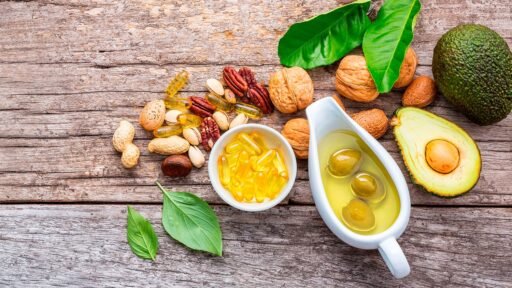Fats are vital for energy, brain health, and vitamin absorption, but not all fats are equal. Understanding their types and sources can transform your diet. Nexus Mag breaks down the main types of fats—saturated, unsaturated, and trans—where to find them, and how they impact your health.
Why Fats Matter
Fats, a key macronutrient, provide 9 calories per gram, fuel cells, and aid absorption of vitamins A, D, E, and K. Your brain is 60% fat, relying on healthy fats for function. Adults should get 20–35% of daily calories from fats, with less than 10% from saturated and minimal trans fats for optimal health.
Main Types of Fats and Their Sources
Fats are triglycerides made of glycerol and fatty acids, classified by structure into saturated, unsaturated (monounsaturated, polyunsaturated), and trans. Each type has unique properties and health effects.
1. Saturated Fats
Solid at room temperature, often from animal sources.
Where Found: Fatty cuts of beef, lamb, full-fat dairy (butter, cheese, cream, ice cream), palm oil, coconut oil.
Health Impact: May raise LDL cholesterol if overconsumed; limit to 10% of calories.
Tip: Use sparingly; replace with unsaturated fats for heart health.
2. Monounsaturated Fats
Liquid at room temperature, heart-healthy.
Where Found: Olive oil, canola oil, avocados, almonds, peanuts, hazelnuts, sesame seeds.
Health Impact: Lower LDL, raise HDL cholesterol; reduce heart disease risk.
Tip: Drizzle 1 tbsp olive oil on salads daily.
3. Polyunsaturated Fats
Include omega-3 and omega-6 fats, essential for brain and heart.
- Omega-3: Salmon, mackerel, sardines, flaxseeds, walnuts, canola oil.
Benefits: Anti-inflammatory, reduce heart disease risk, support brain health.
Stat: 2–3 servings of fatty fish weekly cut heart risk by 15%. - Omega-6: Sunflower seeds, corn oil, soybeans, walnuts, soft spreads.
Benefits: Support cell growth; balance with omega-3s to avoid inflammation.
Tip: Aim for a 4:1 omega-6 to omega-3 ratio; eat fish twice weekly.
4. Trans Fats
Artificial (partially hydrogenated oils) or natural (in some meats/dairy).
Where Found: Processed baked goods, fried foods, some margarines, small amounts in beef, lamb, milk.
Health Impact: Raise LDL, lower HDL; increase heart disease risk.
Tip: Avoid artificial trans fats; check labels for “partially hydrogenated oils.”

How Fats Affect Health
- Energy Source: Fats fuel daily activities and store energy.
- Cell Structure: Form cell membranes, vital for all organs.
- Vitamin Absorption: Enable uptake of fat-soluble vitamins.
- Essential Fats: Omega-3 (ALA, EPA, DHA) and omega-6 (LA) support brain, heart, and growth, as the body can’t produce them.
Overconsumption of any fat can lead to weight gain, as excess calories store as body fat. High saturated or trans fat intake may elevate cholesterol and heart disease risk, while unsaturated fats improve these markers.
Do Fats Make You Gain Weight?
Weight gain depends on total calorie balance, not just fats. Eating more calories than you burn—whether from fats, carbs, or protein—leads to fat storage. However, fats are calorie-dense (9 kcal/g vs. 4 kcal/g for carbs/protein), so portion control is key.
Tip: Balance high-fat foods (e.g., nuts) with low-calorie veggies to manage intake.
How Much Fat Should You Eat?
- Total Fat: 20–35% of daily calories (44–78g for a 2,000-calorie diet).
- Saturated Fat: Less than 10% of calories (22g max for 2,000 calories).
- Trans Fat: Less than 1% of calories; avoid artificial sources.
- Unsaturated Fats: Prioritize for the majority of fat intake.
Many Europeans exceed these limits, with total fat intake reaching 37–46% in some regions, increasing obesity risks.

Fats in Cooking and Food Properties
Fats enhance texture, flavor, and mouthfeel. Saturated fats (butter) are solid, ideal for baking, while unsaturated fats (olive oil) are liquid, great for dressings. Monounsaturated fats (e.g., olive oil) are stable for cooking; polyunsaturated fats (e.g., corn oil) are less stable, better for low-heat uses.
Tip: Use olive oil for sautéing; reserve flaxseed oil for cold dishes to preserve omega-3s.
Omega-3 vs. Omega-6 Balance
Omega-3s (anti-inflammatory) and omega-6s (pro-growth) are essential but compete for metabolism. Modern diets often have too much omega-6 (from processed oils), skewing the ideal 4:1 ratio to 15:1, potentially raising heart disease risk.
Tip: Boost omega-3s with salmon or flaxseeds; limit processed foods high in omega-6 oils.
FAQs About Types of Fats
What are the main types of fats? Saturated, monounsaturated, polyunsaturated (omega-3, omega-6), and trans fats.
Where are these fats found? Saturated in butter, unsaturated in olive oil and fish, trans in processed foods.
Do fats make you fat? Only if you consume excess calories; balance is key.
How much fat is healthy? 20–35% of calories, with minimal saturated and trans fats.
Why are omega-3s important? They reduce inflammation and support heart and brain health.
Eat Fats Wisely
Fats are essential for energy, vitamin absorption, and brain function, but choosing the right types matters. Prioritize unsaturated fats from avocados, fish, and nuts, limit saturated fats, and avoid trans fats for a heart-healthy diet. Explore more nutrition tips in our Lifestyle hub at Nexus Mag.






